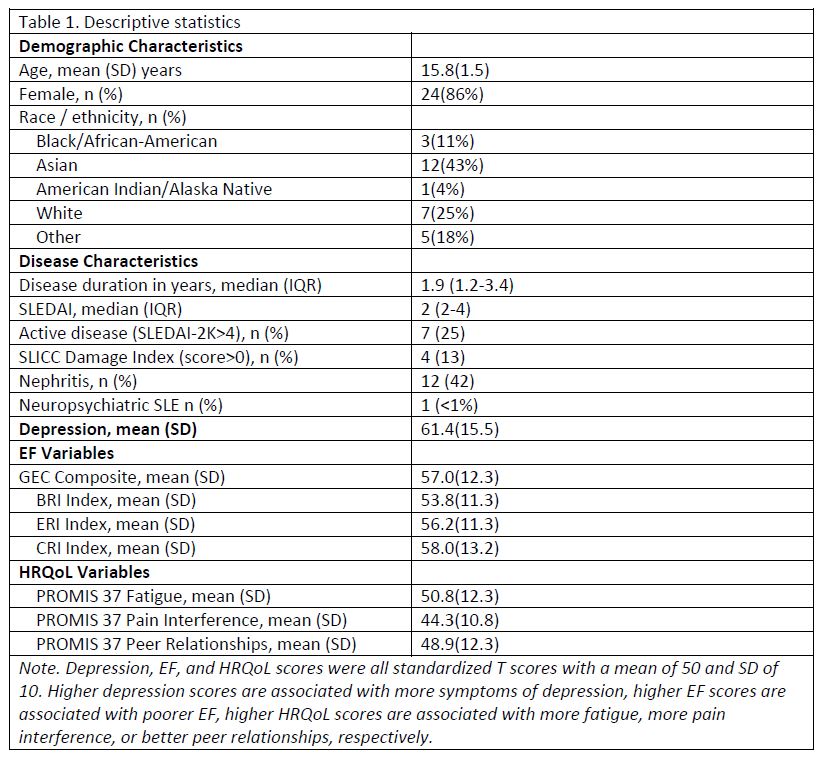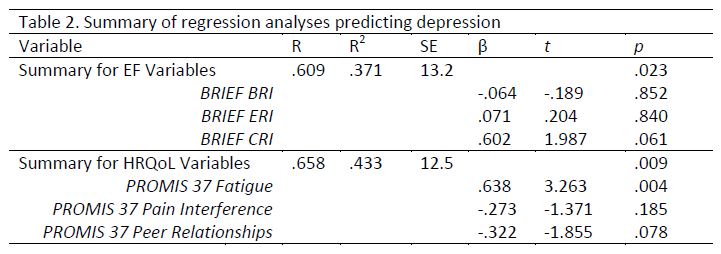Back
Poster Session C
Pediatric autoimmune diseases: Kawasaki disease, juvenile dermatomyositis and juvenile localized scleroderma
Session: (1360–1386) Pediatric Rheumatology – Clinical Poster II: Connective Tissue Disease
1386: The Association of Depression with Executive Function Skills and Health-Related Quality of Life in Youth with Systemic Lupus Erythematosus
Sunday, November 13, 2022
1:00 PM – 3:00 PM Eastern Time
Location: Virtual Poster Hall

Andrea M. Knight, MD
Hospital for Sick Children
Toronto, ON, Canada
Abstract Poster Presenter(s)
Busisiwe Zapparoli1, Sarah Mossad1, Stephanie Fevrier2, Victoria Lishak3, Tala El Tal4, Lawrence Ng1, Paris Moaf1, Joanna Law1, Ibrahim Mohamed5, Linda Hiraki6, Deborah Levy7, ashley Danguecan1 and Andrea Knight4, 1The Hospital for Sick Children, Toronto, ON, Canada, 2The Hospital for Sick Children/University of Toronto, Toronto, ON, Canada, 3The Hospital for Sick Children, Department of Psychology, University of Toronto, Toronto, ON, Canada, 4The Hospital for Sick Children, Division of Rheumatology, Department of Paediatrics, University of Toronto, Toronto, ON, Canada, 5The Hospital for Sick Children, Neurosciences and Mental Health, Research Institute, ON, Canada 3Institute of Biomedical Engineering, University of Toronto, Brampton, ON, Canada, 6The Hospital for Sick Children, Division of Rheumatology, Department of Paediatrics, University of Toronto, Genetics and Genome Biology, SickKids Research Institute, Toronto, ON, Canada, 7Division of Rheumatology, The Hospital for Sick Children; Child Health Evaluative Services, SickKids Research Institute; Department of Paediatrics, University of Toronto, Toronto, ON, Canada
Background/Purpose: Depression is a frequent symptom in childhood-onset SLE (cSLE), and is likely multifactorial. Executive function (EF) refers to conscious and volitional efforts to regulate emotion, cognition, and behaviour. Therefore, poor EF skills are likely related to poor psychological wellbeing. However, although EF is also frequently impaired in cSLE, no research has examined the relationship between EF and depression in cSLE. Similarly, despite evidence of a relationship between health-related quality of life (HRQoL) and depression, the relationship between individual facets of HRQoL (e.g., fatigue, pain interference, peer relationships) and depression is under-researched in cSLE. We examined the association between depression, EF and HRQoL in cSLE.
Methods: We examined a cross-sectional sample of youth ages 12-17 years from a pediatric SLE outpatient clinic at a major tertiary hospital between January 2020 and May 2022. Patients met ACR or SLICC classification criteria for SLE. Depression symptoms were measured using the Beck Depression Inventory or Children's Depression Inventory. The self-report version of The Behavior Rating Inventory of Executive Function, Second Edition (BRIEF-2) was used to measure EF. Pearson correlation was used to determine whether there was a relationship between depression scores and total scores of the BRIEF-2 (Global Executive Composite, GEC). The three indices that make up the BRIEF-2 (Behavior Regulation Index, BRI; Cognitive Regulation Index, CRI; Emotion Regulation Index, ERI) were used for further analyses of EF. The fatigue, pain interference, and peer relationships domains of the Patient-Reported Outcomes Measurement Information System (PROMIS) Pediatric Profile 37 (PROMIS 37; a self-report measure) were used to measure HRQoL. Two separate multiple linear regression models tested the association between depression and i) the three BRIEF-2 indices, and ii) three PROMIS measures for HRQoL.
Results: Twenty-eight youth (mean age 15.8 ± SD 1.5 years, 86% female, 75% self-identified as non-white) were included in the analysis (Table 1). The mean ± SD depression score was 61.4 ± 15.5. The mean ± SD EF scores were 57.0 ± 12.3 for the GEC and 53.8 ± 11.3 for the BRI, 56.3 ± 11.3 for the ERI, and 58.0 ± 13.2 for the CRI indices of the BRIEF-2. The mean ± SD HRQoL scores were 50.8 ± 12.3 for the fatigue, 44.3 ± 10.8 for the pain interference, and 48.9 ± 12.3 for the peer relationships domains of the PROMIS 37. There was a significant correlation between depression and overall EF (GEC; r = .580, p = .003). The first multiple regression (Table 2) revealed that the three EF indices predicted 37.1% of the variance in depression and the model was significant, F(3, 20) = 3.930, p = .023. The second multiple regression (Table 2) revealed that the three facets of HRQoL (fatigue, pain interference, peer relationships) predicted 43.3% of the variance in depression and the model was significant, F(3, 20) = 5.093, p = .0009. Fatigue alone added statistically significantly to the prediction (p = .004).
Conclusion: On average, depression was high, and was associated with poorer EF and higher levels of fatigue. Future research should continue to examine the relationship between depression, fatigue and EF in cSLE.
 Descriptive statistics of the sample of 28 cSLE youth
Descriptive statistics of the sample of 28 cSLE youth
 Summary of the two regression analyses predicting depression in the sample of cSLE youth
Summary of the two regression analyses predicting depression in the sample of cSLE youth
Disclosures: B. Zapparoli, None; S. Mossad, None; S. Fevrier, None; V. Lishak, None; T. El Tal, None; L. Ng, None; P. Moaf, None; J. Law, None; I. Mohamed, None; L. Hiraki, None; D. Levy, None; a. Danguecan, None; A. Knight, None.
Background/Purpose: Depression is a frequent symptom in childhood-onset SLE (cSLE), and is likely multifactorial. Executive function (EF) refers to conscious and volitional efforts to regulate emotion, cognition, and behaviour. Therefore, poor EF skills are likely related to poor psychological wellbeing. However, although EF is also frequently impaired in cSLE, no research has examined the relationship between EF and depression in cSLE. Similarly, despite evidence of a relationship between health-related quality of life (HRQoL) and depression, the relationship between individual facets of HRQoL (e.g., fatigue, pain interference, peer relationships) and depression is under-researched in cSLE. We examined the association between depression, EF and HRQoL in cSLE.
Methods: We examined a cross-sectional sample of youth ages 12-17 years from a pediatric SLE outpatient clinic at a major tertiary hospital between January 2020 and May 2022. Patients met ACR or SLICC classification criteria for SLE. Depression symptoms were measured using the Beck Depression Inventory or Children's Depression Inventory. The self-report version of The Behavior Rating Inventory of Executive Function, Second Edition (BRIEF-2) was used to measure EF. Pearson correlation was used to determine whether there was a relationship between depression scores and total scores of the BRIEF-2 (Global Executive Composite, GEC). The three indices that make up the BRIEF-2 (Behavior Regulation Index, BRI; Cognitive Regulation Index, CRI; Emotion Regulation Index, ERI) were used for further analyses of EF. The fatigue, pain interference, and peer relationships domains of the Patient-Reported Outcomes Measurement Information System (PROMIS) Pediatric Profile 37 (PROMIS 37; a self-report measure) were used to measure HRQoL. Two separate multiple linear regression models tested the association between depression and i) the three BRIEF-2 indices, and ii) three PROMIS measures for HRQoL.
Results: Twenty-eight youth (mean age 15.8 ± SD 1.5 years, 86% female, 75% self-identified as non-white) were included in the analysis (Table 1). The mean ± SD depression score was 61.4 ± 15.5. The mean ± SD EF scores were 57.0 ± 12.3 for the GEC and 53.8 ± 11.3 for the BRI, 56.3 ± 11.3 for the ERI, and 58.0 ± 13.2 for the CRI indices of the BRIEF-2. The mean ± SD HRQoL scores were 50.8 ± 12.3 for the fatigue, 44.3 ± 10.8 for the pain interference, and 48.9 ± 12.3 for the peer relationships domains of the PROMIS 37. There was a significant correlation between depression and overall EF (GEC; r = .580, p = .003). The first multiple regression (Table 2) revealed that the three EF indices predicted 37.1% of the variance in depression and the model was significant, F(3, 20) = 3.930, p = .023. The second multiple regression (Table 2) revealed that the three facets of HRQoL (fatigue, pain interference, peer relationships) predicted 43.3% of the variance in depression and the model was significant, F(3, 20) = 5.093, p = .0009. Fatigue alone added statistically significantly to the prediction (p = .004).
Conclusion: On average, depression was high, and was associated with poorer EF and higher levels of fatigue. Future research should continue to examine the relationship between depression, fatigue and EF in cSLE.
 Descriptive statistics of the sample of 28 cSLE youth
Descriptive statistics of the sample of 28 cSLE youth Summary of the two regression analyses predicting depression in the sample of cSLE youth
Summary of the two regression analyses predicting depression in the sample of cSLE youthDisclosures: B. Zapparoli, None; S. Mossad, None; S. Fevrier, None; V. Lishak, None; T. El Tal, None; L. Ng, None; P. Moaf, None; J. Law, None; I. Mohamed, None; L. Hiraki, None; D. Levy, None; a. Danguecan, None; A. Knight, None.

